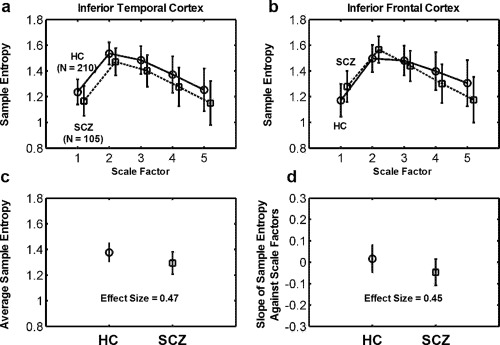Figure 3.

Two types of complexity change according to the MSE complexity profile of BOLD signals (scale factor vs. mean ± SD of sample entropy) extracted from (a) the inferior temporal cortex and (b) the inferior frontal cortex. The MSE complexity profile of (a) the inferior temporal cortex showed lower BOLD sample entropy in patients with schizophrenia (SCZ) than in healthy comparison (HC) subjects in all scale factors (P FWE < 0.05). By contrast, the MSE complexity profile of (b) the inferior frontal cortex showed higher BOLD entropy in SCZ than in HC in Scale 1, and the entropy values in SCZ exhibited a crossover with the MSE profile of HC. SCZ exhibited a lower BOLD entropy than HC in Scales 4 and 5 (P FWE were < 0.05 in Scales 1, 4, and 5). We defined two quantitative measures for assessing these two types of complexity change toward (a) regularity and (b) randomness. (c) For the regularity type of complexity change, we used the average sample entropy as an index to assess the extent of increased regularity of BOLD signals in SCZ. (d) For the randomness type of complexity change, we used the slope of the sample entropy against scale factors 1–5 to assess the extent of increased randomness of BOLD signals in SCZ.
